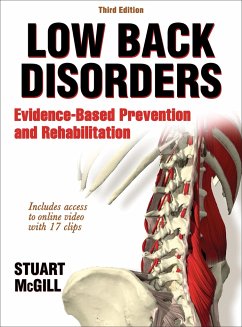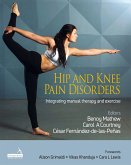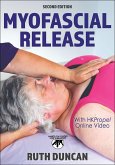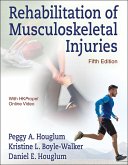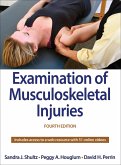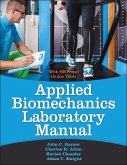- Gebundenes Buch
- Merkliste
- Auf die Merkliste
- Bewerten Bewerten
- Teilen
- Produkt teilen
- Produkterinnerung
- Produkterinnerung
The third edition of Low Back Disorders contains all of the tools for treating those with low back maladies. The text provides detailed insights into injury assessment by an extensively expanded set of tests with accompanying instructions. The web resource contains an online video suite that showcases various exercises and assessments.
Andere Kunden interessierten sich auch für
![A Practitioner's Guide to Clinical Cupping A Practitioner's Guide to Clinical Cupping]() Daniel LawrenceA Practitioner's Guide to Clinical Cupping16,99 €
Daniel LawrenceA Practitioner's Guide to Clinical Cupping16,99 €![Hip and Knee Pain Disorders Hip and Knee Pain Disorders]() Benoy MathewHip and Knee Pain Disorders84,99 €
Benoy MathewHip and Knee Pain Disorders84,99 €![Myofascial Release Myofascial Release]() Ruth DuncanMyofascial Release40,99 €
Ruth DuncanMyofascial Release40,99 €![A Clinical Guide to Surface Palpation A Clinical Guide to Surface Palpation]() Michael MasaracchioA Clinical Guide to Surface Palpation105,99 €
Michael MasaracchioA Clinical Guide to Surface Palpation105,99 €![Rehabilitation of Musculoskeletal Injuries Rehabilitation of Musculoskeletal Injuries]() Peggy A. HouglumRehabilitation of Musculoskeletal Injuries171,99 €
Peggy A. HouglumRehabilitation of Musculoskeletal Injuries171,99 €![Examination of Musculoskeletal Injuries Examination of Musculoskeletal Injuries]() Sandra J. ShultzExamination of Musculoskeletal Injuries108,99 €
Sandra J. ShultzExamination of Musculoskeletal Injuries108,99 €![Applied Biomechanics Lab Manual Applied Biomechanics Lab Manual]() John C. GarnerApplied Biomechanics Lab Manual80,99 €
John C. GarnerApplied Biomechanics Lab Manual80,99 €-
-
-
The third edition of Low Back Disorders contains all of the tools for treating those with low back maladies. The text provides detailed insights into injury assessment by an extensively expanded set of tests with accompanying instructions. The web resource contains an online video suite that showcases various exercises and assessments.
Hinweis: Dieser Artikel kann nur an eine deutsche Lieferadresse ausgeliefert werden.
Hinweis: Dieser Artikel kann nur an eine deutsche Lieferadresse ausgeliefert werden.
Produktdetails
- Produktdetails
- Verlag: Human Kinetics Publishers
- Third Edition
- Seitenzahl: 424
- Erscheinungstermin: 17. November 2015
- Englisch
- Abmessung: 287mm x 220mm x 32mm
- Gewicht: 1242g
- ISBN-13: 9781450472913
- ISBN-10: 1450472915
- Artikelnr.: 42801620
- Herstellerkennzeichnung
- Libri GmbH
- Europaallee 1
- 36244 Bad Hersfeld
- gpsr@libri.de
- Verlag: Human Kinetics Publishers
- Third Edition
- Seitenzahl: 424
- Erscheinungstermin: 17. November 2015
- Englisch
- Abmessung: 287mm x 220mm x 32mm
- Gewicht: 1242g
- ISBN-13: 9781450472913
- ISBN-10: 1450472915
- Artikelnr.: 42801620
- Herstellerkennzeichnung
- Libri GmbH
- Europaallee 1
- 36244 Bad Hersfeld
- gpsr@libri.de
Stuart McGill, PhD, is a professor at the University of Waterloo, Ontario, Canada, and a world-renowned lecturer and expert in spine function, injury prevention, and rehabilitation. He has written more than 300 scientific publications on lumbar function, mechanisms of low back injury, investigation of rehabilitation programs matched to specific categories of back pain patients, and the formulation of work-related injury avoidance strategies. He has received several awards for his work, including the Volvo Bioengineering Award for Low Back Pain Research from Sweden. McGill has been an invited lecturer at many universities and delivered more than 300 addresses to societies around the world. As a consultant, he has provided expertise on assessment and reduction of the risk of low back injury to government agencies, corporations, professional athletes and teams, and legal firms. He is one of the few scientists who, in addition to performing research, is regularly requested by the medical profession to consult with challenging patients from around the world.
Part I Scientific Foundation
Chapter 1. Introduction to the Issues and Scientific Approach Unique to
This Book
Legislative Landscape: The Unfortunate Adverse Impact on Painful Backs
Deficiencies in Current Diagnostic Practices
Inadequacies in Current Care and Prevention
Mechanical Loading and the Process of Injury: A Low Back Tissue Injury
Primer
Excellent Clinicians and Excellent Practice
Unique Scientific Foundation of This Book
In Vitro Lab
In Vivo Lab
A Final Note
Chapter 2. Epidemiological Studies and What They Really Mean
Influence of Randomized Controlled Trials and Other Epidemiological
Approaches
Misunderstandings of Epidemiology
Multidimensional Links Among Biomechanical, Psychosocial, and Personal
Variables
Are Biomechanical Variables and Psychosocial Variables Distinct?
How Do Biomechanical Factors Affect LBD?
Links Between Personal Factors and LBD
Studies of Exercise Intervention
Practical Application: What the Evidence Supports
What Works Clinically
A Final Note
Chapter 3. Functional Anatomy of the Lumbar Spine
Anatomy Trains
Basic Neural Structure
Vascular Anatomy
Vertebrae
Sacroiliac Joints
Intervertebral Disc
Muscles
Ligaments
Lumbodorsal Fascia (LDF)
Quick Review of the Pelvis, Hips, and Related Musculature
Clinically Relevant Aspects of Pain and Anatomic Structure
A Final Note
Chapter 4. Normal and Injury Mechanics of the Lumbar Spine
Kinematic Properties of the Thoracolumbar Spine
Kinetics and Normal Lumbar Spine Mechanics
Dubious Lifting Mechanisms
Other Important Mechanisms of Normal Spine Mechanics
Injury Mechanisms
Biomechanical and Physiological Changes Following Injury
A Final Note
Chapter 5. Myths and Realities of Lumbar Spine Stability
Why Spine Stability Is Important for Everyone
Stability: A Qualitative Analogy
Quantitative Foundation of Stability
Stability Myths, Facts, and Clinical Implications
A Final Note
Part II Injury Prevention
Chapter 6. LBD Risk Assessment
Brief Review of the Risk Factors for LBD
NIOSH Approach to Risk Assessment
Snook Psychophysical Approach
Lumbar Motion Monitor (LMM)
Ergowatch
Biological Signal-Driven Model Approaches
A Final Note
Chapter 7. Reducing the Risk of Low Back Injury
Lessons From the Literature
LBD Prevention for Workers
The Question of Back Belts
LBD Prevention for Employers
Injury Prevention Primer
A Note for Consultants
Reducing the Risk in Athletes
A Final Note
Part III Low Back Rehabilitation
Chapter 8. Building Better Rehabilitation Programs for Low Back Injuries
Pain-Reducing Mechanisms of Exercise
Five-Stage Back Training Program
Finding the Best Approach
Stages of Patient Progression
Guidelines for Developing the Best Exercise Regimen
A Final Note
Chapter 9. Evaluating the Patient
Most Crucial Element in Evaluation
First Clinician-Patient Meeting
Assessing Posture and Movement Quality
Some Provocation Tests
Some Functional Screens
Testing Muscle Endurance
A Final Note
Chapter 10. Developing the Exercise Program
Philosophy of Low Back Exercise Design
Clinical Wisdom
Thoughts on Mobility
Identifying Safe and Effective Exercises
Beginner's Program for Pain Control and Stabilization
Exercises That May Be Used in a Stabilization Program
Special Conditions
A Final Note
Chapter 11. Advanced Exercises
Safely Increasing Challenges
Occupational and Athletic Work Hardening
A Final Note
Chapter 1. Introduction to the Issues and Scientific Approach Unique to
This Book
Legislative Landscape: The Unfortunate Adverse Impact on Painful Backs
Deficiencies in Current Diagnostic Practices
Inadequacies in Current Care and Prevention
Mechanical Loading and the Process of Injury: A Low Back Tissue Injury
Primer
Excellent Clinicians and Excellent Practice
Unique Scientific Foundation of This Book
In Vitro Lab
In Vivo Lab
A Final Note
Chapter 2. Epidemiological Studies and What They Really Mean
Influence of Randomized Controlled Trials and Other Epidemiological
Approaches
Misunderstandings of Epidemiology
Multidimensional Links Among Biomechanical, Psychosocial, and Personal
Variables
Are Biomechanical Variables and Psychosocial Variables Distinct?
How Do Biomechanical Factors Affect LBD?
Links Between Personal Factors and LBD
Studies of Exercise Intervention
Practical Application: What the Evidence Supports
What Works Clinically
A Final Note
Chapter 3. Functional Anatomy of the Lumbar Spine
Anatomy Trains
Basic Neural Structure
Vascular Anatomy
Vertebrae
Sacroiliac Joints
Intervertebral Disc
Muscles
Ligaments
Lumbodorsal Fascia (LDF)
Quick Review of the Pelvis, Hips, and Related Musculature
Clinically Relevant Aspects of Pain and Anatomic Structure
A Final Note
Chapter 4. Normal and Injury Mechanics of the Lumbar Spine
Kinematic Properties of the Thoracolumbar Spine
Kinetics and Normal Lumbar Spine Mechanics
Dubious Lifting Mechanisms
Other Important Mechanisms of Normal Spine Mechanics
Injury Mechanisms
Biomechanical and Physiological Changes Following Injury
A Final Note
Chapter 5. Myths and Realities of Lumbar Spine Stability
Why Spine Stability Is Important for Everyone
Stability: A Qualitative Analogy
Quantitative Foundation of Stability
Stability Myths, Facts, and Clinical Implications
A Final Note
Part II Injury Prevention
Chapter 6. LBD Risk Assessment
Brief Review of the Risk Factors for LBD
NIOSH Approach to Risk Assessment
Snook Psychophysical Approach
Lumbar Motion Monitor (LMM)
Ergowatch
Biological Signal-Driven Model Approaches
A Final Note
Chapter 7. Reducing the Risk of Low Back Injury
Lessons From the Literature
LBD Prevention for Workers
The Question of Back Belts
LBD Prevention for Employers
Injury Prevention Primer
A Note for Consultants
Reducing the Risk in Athletes
A Final Note
Part III Low Back Rehabilitation
Chapter 8. Building Better Rehabilitation Programs for Low Back Injuries
Pain-Reducing Mechanisms of Exercise
Five-Stage Back Training Program
Finding the Best Approach
Stages of Patient Progression
Guidelines for Developing the Best Exercise Regimen
A Final Note
Chapter 9. Evaluating the Patient
Most Crucial Element in Evaluation
First Clinician-Patient Meeting
Assessing Posture and Movement Quality
Some Provocation Tests
Some Functional Screens
Testing Muscle Endurance
A Final Note
Chapter 10. Developing the Exercise Program
Philosophy of Low Back Exercise Design
Clinical Wisdom
Thoughts on Mobility
Identifying Safe and Effective Exercises
Beginner's Program for Pain Control and Stabilization
Exercises That May Be Used in a Stabilization Program
Special Conditions
A Final Note
Chapter 11. Advanced Exercises
Safely Increasing Challenges
Occupational and Athletic Work Hardening
A Final Note
Part I Scientific Foundation
Chapter 1. Introduction to the Issues and Scientific Approach Unique to
This Book
Legislative Landscape: The Unfortunate Adverse Impact on Painful Backs
Deficiencies in Current Diagnostic Practices
Inadequacies in Current Care and Prevention
Mechanical Loading and the Process of Injury: A Low Back Tissue Injury
Primer
Excellent Clinicians and Excellent Practice
Unique Scientific Foundation of This Book
In Vitro Lab
In Vivo Lab
A Final Note
Chapter 2. Epidemiological Studies and What They Really Mean
Influence of Randomized Controlled Trials and Other Epidemiological
Approaches
Misunderstandings of Epidemiology
Multidimensional Links Among Biomechanical, Psychosocial, and Personal
Variables
Are Biomechanical Variables and Psychosocial Variables Distinct?
How Do Biomechanical Factors Affect LBD?
Links Between Personal Factors and LBD
Studies of Exercise Intervention
Practical Application: What the Evidence Supports
What Works Clinically
A Final Note
Chapter 3. Functional Anatomy of the Lumbar Spine
Anatomy Trains
Basic Neural Structure
Vascular Anatomy
Vertebrae
Sacroiliac Joints
Intervertebral Disc
Muscles
Ligaments
Lumbodorsal Fascia (LDF)
Quick Review of the Pelvis, Hips, and Related Musculature
Clinically Relevant Aspects of Pain and Anatomic Structure
A Final Note
Chapter 4. Normal and Injury Mechanics of the Lumbar Spine
Kinematic Properties of the Thoracolumbar Spine
Kinetics and Normal Lumbar Spine Mechanics
Dubious Lifting Mechanisms
Other Important Mechanisms of Normal Spine Mechanics
Injury Mechanisms
Biomechanical and Physiological Changes Following Injury
A Final Note
Chapter 5. Myths and Realities of Lumbar Spine Stability
Why Spine Stability Is Important for Everyone
Stability: A Qualitative Analogy
Quantitative Foundation of Stability
Stability Myths, Facts, and Clinical Implications
A Final Note
Part II Injury Prevention
Chapter 6. LBD Risk Assessment
Brief Review of the Risk Factors for LBD
NIOSH Approach to Risk Assessment
Snook Psychophysical Approach
Lumbar Motion Monitor (LMM)
Ergowatch
Biological Signal-Driven Model Approaches
A Final Note
Chapter 7. Reducing the Risk of Low Back Injury
Lessons From the Literature
LBD Prevention for Workers
The Question of Back Belts
LBD Prevention for Employers
Injury Prevention Primer
A Note for Consultants
Reducing the Risk in Athletes
A Final Note
Part III Low Back Rehabilitation
Chapter 8. Building Better Rehabilitation Programs for Low Back Injuries
Pain-Reducing Mechanisms of Exercise
Five-Stage Back Training Program
Finding the Best Approach
Stages of Patient Progression
Guidelines for Developing the Best Exercise Regimen
A Final Note
Chapter 9. Evaluating the Patient
Most Crucial Element in Evaluation
First Clinician-Patient Meeting
Assessing Posture and Movement Quality
Some Provocation Tests
Some Functional Screens
Testing Muscle Endurance
A Final Note
Chapter 10. Developing the Exercise Program
Philosophy of Low Back Exercise Design
Clinical Wisdom
Thoughts on Mobility
Identifying Safe and Effective Exercises
Beginner's Program for Pain Control and Stabilization
Exercises That May Be Used in a Stabilization Program
Special Conditions
A Final Note
Chapter 11. Advanced Exercises
Safely Increasing Challenges
Occupational and Athletic Work Hardening
A Final Note
Chapter 1. Introduction to the Issues and Scientific Approach Unique to
This Book
Legislative Landscape: The Unfortunate Adverse Impact on Painful Backs
Deficiencies in Current Diagnostic Practices
Inadequacies in Current Care and Prevention
Mechanical Loading and the Process of Injury: A Low Back Tissue Injury
Primer
Excellent Clinicians and Excellent Practice
Unique Scientific Foundation of This Book
In Vitro Lab
In Vivo Lab
A Final Note
Chapter 2. Epidemiological Studies and What They Really Mean
Influence of Randomized Controlled Trials and Other Epidemiological
Approaches
Misunderstandings of Epidemiology
Multidimensional Links Among Biomechanical, Psychosocial, and Personal
Variables
Are Biomechanical Variables and Psychosocial Variables Distinct?
How Do Biomechanical Factors Affect LBD?
Links Between Personal Factors and LBD
Studies of Exercise Intervention
Practical Application: What the Evidence Supports
What Works Clinically
A Final Note
Chapter 3. Functional Anatomy of the Lumbar Spine
Anatomy Trains
Basic Neural Structure
Vascular Anatomy
Vertebrae
Sacroiliac Joints
Intervertebral Disc
Muscles
Ligaments
Lumbodorsal Fascia (LDF)
Quick Review of the Pelvis, Hips, and Related Musculature
Clinically Relevant Aspects of Pain and Anatomic Structure
A Final Note
Chapter 4. Normal and Injury Mechanics of the Lumbar Spine
Kinematic Properties of the Thoracolumbar Spine
Kinetics and Normal Lumbar Spine Mechanics
Dubious Lifting Mechanisms
Other Important Mechanisms of Normal Spine Mechanics
Injury Mechanisms
Biomechanical and Physiological Changes Following Injury
A Final Note
Chapter 5. Myths and Realities of Lumbar Spine Stability
Why Spine Stability Is Important for Everyone
Stability: A Qualitative Analogy
Quantitative Foundation of Stability
Stability Myths, Facts, and Clinical Implications
A Final Note
Part II Injury Prevention
Chapter 6. LBD Risk Assessment
Brief Review of the Risk Factors for LBD
NIOSH Approach to Risk Assessment
Snook Psychophysical Approach
Lumbar Motion Monitor (LMM)
Ergowatch
Biological Signal-Driven Model Approaches
A Final Note
Chapter 7. Reducing the Risk of Low Back Injury
Lessons From the Literature
LBD Prevention for Workers
The Question of Back Belts
LBD Prevention for Employers
Injury Prevention Primer
A Note for Consultants
Reducing the Risk in Athletes
A Final Note
Part III Low Back Rehabilitation
Chapter 8. Building Better Rehabilitation Programs for Low Back Injuries
Pain-Reducing Mechanisms of Exercise
Five-Stage Back Training Program
Finding the Best Approach
Stages of Patient Progression
Guidelines for Developing the Best Exercise Regimen
A Final Note
Chapter 9. Evaluating the Patient
Most Crucial Element in Evaluation
First Clinician-Patient Meeting
Assessing Posture and Movement Quality
Some Provocation Tests
Some Functional Screens
Testing Muscle Endurance
A Final Note
Chapter 10. Developing the Exercise Program
Philosophy of Low Back Exercise Design
Clinical Wisdom
Thoughts on Mobility
Identifying Safe and Effective Exercises
Beginner's Program for Pain Control and Stabilization
Exercises That May Be Used in a Stabilization Program
Special Conditions
A Final Note
Chapter 11. Advanced Exercises
Safely Increasing Challenges
Occupational and Athletic Work Hardening
A Final Note

